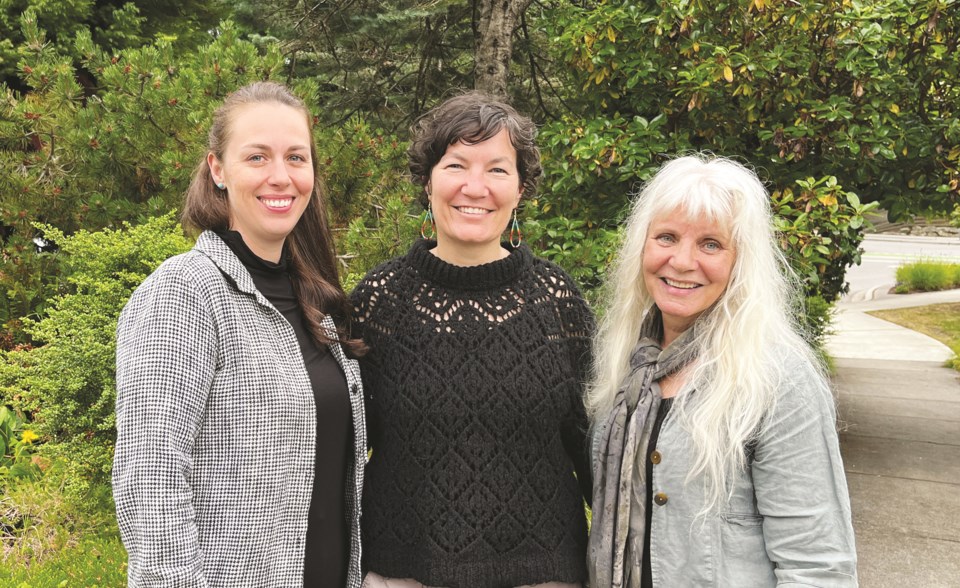An exhibition by a shíshálh artist now showing at Sechelt’s Sunshine Coast Arts Centre illustrates the creative potential of collaboration even when contributors are separated by death. Nadine Ryan’s We Will Visit in Our Dreams: Death, Dying and Continuing Bonds opened during a public reception on June 27, with Ryan in attendance before returning to her Ph.D studies at the University of Toronto.
“My view is that the world, but especially Indigenous people, need a different way of relating with death,” said Ryan, who grew up on Skwxwú7mesh territory. “It’s something we all face. Indigenous people had a very different relationship with the dying process, and right now we need to bring ancestral knowledge back to the forefront, while people from outside the Indigenous community could benefit from another perspective as well.”
Cycles of death and rebirth are subtly evoked by Ryan’s digital photography and collage works. In the black-and-white print Salmon, a fish’s decaying body is visible under the waves, its mouth agape in an ultimate rebuke of mortality. In s-ḵwetl (a title that combines the words for smoke and journeying in the she shashishalhem language), an otherworldly plume spirals upward against inky blankness. Her collage series A Meeting Place combines the liminality of shorelines with ethereal shapes and colours: islets and thick-forested ridges punctuate placid tidewater, each isolated but staunch.
The showcase had its genesis in 2019, when Ryan’s grandparents passed away. She visited her grandmother whose last seven days were spent in a hospital room filled with people. “I started to notice how social and communal death is,” Ryan observed. “The room was full of physical people, but it was also full of spirits: spirits [my grandmother] was seeing, and spirits we felt.”
A medical practitioner pulled her aside and explained that the elderly woman was hallucinating. The comment was well-intended but short-sighted. Ryan recalled an observation from Dr. Kim TallBear (professor of Indigenous Peoples, Technoscience, and Society at the University of Alberta): “[TallBear] talks about how in the non-Indigenous or settler worlds, capital-S science and scientists have a really hard time with anything spiritual. But for Indigenous people, they somehow manage to hold those things together.”
Ryan’s work harmonizes the concepts of geography and family. In the collage shíshálh swiya she layers a map of the traditional shíshálh homeland atop an archival photograph of the Sechelt graveyard, blended with a painting of the identical perspective by Emily Carr. Candid photographs of relations — embracing, dancing, mugging for the camera — encircle the composite image.
In other instances, the connections are more covert. At the heart of This day is a rose is a poem written by Ryan’s aunt Roxy Bain, who died at the age of 19. Ryan developed an installation that surrounds the handwritten verse with a bed of multicoloured roses, wan and supine. In Seeds, she created an image to complement a pencil-and-pen artwork by her aunt Maggie Bain (on loan from the tems swiya Museum) that depicts young Indigenous students shepherded by cowled nuns.
Ryan’s digital collage situates the original archival photo — black and white, indistinct, foreboding — behind a blaze of green and sapphire foliage. “I kept hearing people in different Indigenous communities say they tried to bury us, but they didn’t know we were seeds,” she said. “Both [Maggie’s] creation and mine were all happening around the time of revealing the deaths of children at the Kamloops school. I kept hearing people say that the children didn’t die for nothing: their deaths were seeds for change.”
The exhibition was supported by the Ontario Arts Council and the Canada Council for the Arts, which also helped realize the Dream Café event held the following day as part of the gallery’s syíyaya Days offerings. During the Dream Café, participants took part in a focused discussion on the intersection between death, dying and dreaming.
“What is it like, or what does it mean to collaborate with people who aren’t here? And how do we do that?” asked Ryan. She filled a woven red cedar basket with cards bearing Indigenous insights on the proximity of mortal and spirit words. Underneath is a tablecloth crocheted by her great-grandmother, Lottie Hansen. “It’s the last thing she created,” she said. “I thought: if we include this too, we are joining more people to the show.”
Nadine Ryan’s We Will Visit in Our Dreams continues at the Sunshine Coast Arts Centre until Aug. 17.



